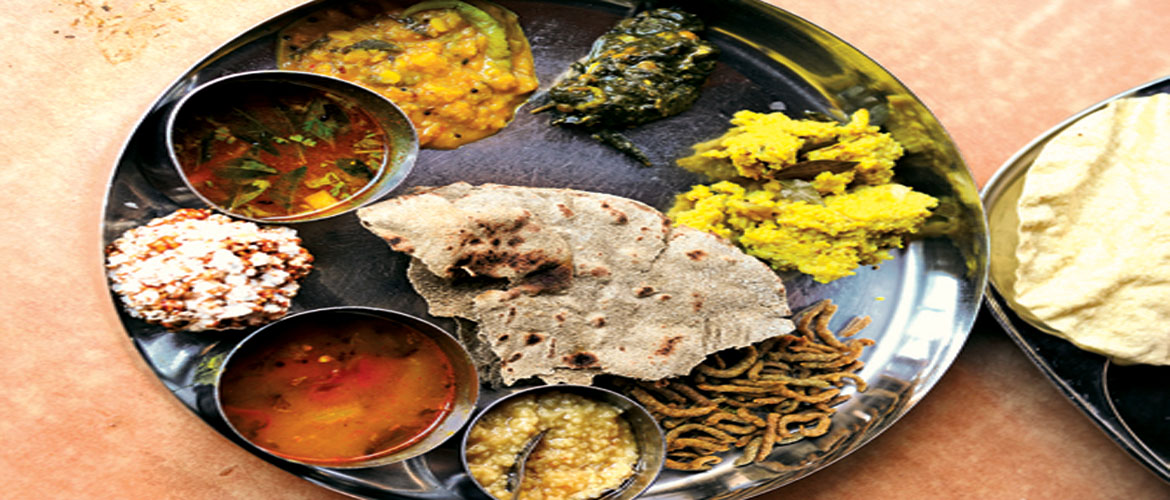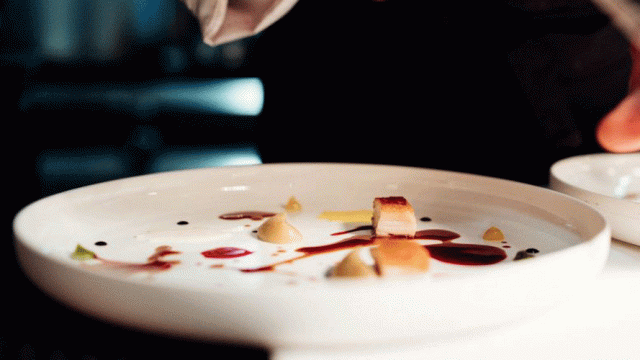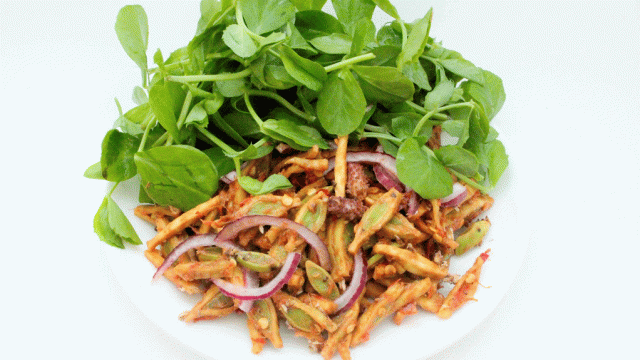From the rustic to the exquisite, Telangana’s cuisine is a gastronomic delight. Carrying unmistakable stamps
Telanganaites are a hardy lot, unfazed by the predominantly hot climate and semi-arid conditions of their state. The food of the region, too, reflects this robust character. Most dishes are rustic, with the traditional meal consisting of flat breads, curry dishes, savouries and accompaniments as well as pickles.
The traditional breads are made of millet or sorghum although wheat chapatti is also eaten in regular meals. Curry dishes incorporate bold flavours such as chilli, tamarind, sesame seeds and coconut. Many dishes are non-vegetarian, with chicken and mutton being the preferred proteins. The eternal favourites – idli, dosa and vada – are also relished across the board.
Of course, state capital Hyderabad has its own distinctive cuisine. The Qutub Shahi and Nizami influence of about 400 years gave Indian gastronomy a much-celebrated chapter that includes biryani, haleem, dalcha, murg ka kurma, qubani ka meetha and many other delicacies. Much of the cuisine was developed in the royal kitchens. Slow cooking, that has been influenced by the Dum Pukht method used in Awadhi cuisine, is the hallmark of Hyderabadi cuisine.
SNACKS
Like snacks across India, many of these dishes are calorie-rich, addictively savoury and fried. However, traditionally, many millets such as jowar, ragi, barley etc also were used extensively in snacks. Idli, dosa and vada are made using these millets rather than rice. Here are some other popular snacks:

Sarva Pindi
This popular breakfast dish is a pancake made of rice flour, chana dal, ginger, garlic, sesame seeds, curry leaves and green chillies. The combination of grains, pulses and spices makes it a hearty meal, which sustains the eater for many hours.

Sakinalu
A mandatory dish prepared during the harvest festival of Sankranthi, sakinalu is a spiral savoury, similar to the Maharashtrian chakli or the Tamilian murukku. It is made from rice flour, carom seeds and sesame seeds. The dough is traditionally stretched by hand and made into a spiral, left to dry and then deep fried to crunchy perfection.
Karijelu
The outer pastry of these delicious half-moon dumplings are made of plain flour. The stuffing, however, varies – from semolina, coconut and sugar to peanut powder and chickpea flour. Some even stuff it with chicken or mutton mince. Karijelu is also known as kajjikaayalu. The dumplings are deep fried to a golden brown.

CURRY DISHES
Tamarind, spring onions, green chillies, sesame and spices are mainstays of many curries in Telangana. Red chillies and asafoetida also impart biting heat. Main course dishes are unapologetically fiery. One theory suggests this is deliberately so, designed to prevent people from eating too much, since Telangana is not an agriculturally bountiful region. Be that as it may, the curries, both vegetarian and non-vegetarian, are full of flavour and complexity. Still, there are very few places, even in Hyderabad, that offer these dishes on their regular menu.
As opposed to rice that is widely eaten in Andhra Pradesh, breads are the curry carriers in Telangana. But, rather than chapatti that is common across north India, breads here are often made from millets. Sajja rotte (barley), makka rotte (maize), jonna rotte (jowar) are some of the breads that are made from millets.
Among meats, chicken and mutton are popular, while seafood, such as fish and prawns, is used more in the dried form. Among vegetables snake gourd, banana, eggplant and lentils are widely used. Peanuts and cashewnuts are often used to add textural contrast and body to dishes.There are two kinds of curries: koora is the regular curry, while vepudu is the reduction and, therefore, much more intense in flavour.

MAIN COURSE
Pachi Pulusu
The word pachi means raw, and although this stew-like dish resembles rasam, it is not prepared in the same manner. Pachi pulusu is made from tamarind, onions, chillies and jaggery and several spices. A tempering using oil, green and red chillies, curry leaves, mustard seeds, cumin seeds and sesame seeds is made and poured over the tamarind juice whose sharp tang is balanced with salt and jaggery or sugar. Chopped onions are also added and the dish is sometimes finished with coriander leaves. It is usually eaten during summers as it is believed to have cooling properties. Served alongside hot rice, it is one of the most popular and common dishes of Telangana.
Gongura Chana Dal
Sorrel leaves or gongura is a versatile cooking ingredient. It is used in vegetarian dishes as well as mamasam (mutton) and royallu (shrimp) and even pickles. In this dish, the leaves are combined with lentils for a hearty result. Soaked chana dal (Bengal gram) and finely chopped sorrel leaves, onions and green chillies are cooked in a vessel. Later a tempering of garlic, fenugreek seeds, urad dal (split black gram) and asafoetida is added. A dash of tamarind is sometimes added for a bit of tang.
Bachali Kura
A leafy vegetable known as vine spinach or Ceylon spinach is used in this dish. It gets its tang from tomatoes and its mild pungency from green chillies, onions, ginger and garlic.
Vankaya Pulusu
This main course dish featuring brinjal is quite popular. Made using very few ingredients and virtually no spices, it relies on tamarind and green chillies for its flavour component. The brinjals are cubed and cooked until they almost collapse. The brinjal can be replaced with drumstick, gourd or okra.

Chapala Pulusu
Although the state is landlocked, fish is present in its cuisine. Chapala pulusu, which has fenugreek powder and leaves as well as the ubiquitous tamarind juice, is a versatile dish. Spring onion also features in the dish. The gravy is tangy and goes well with steaming hot rice.
Golichhina Mamasam
Golichhina roughly translates as fried. Golichhina mamasam is nothing but spicy mutton fry. Although not a curry dish, the fry has a fiery masala with very basic ingredients such as onions, ginger and garlic.
Natu Kodi Pulusu
Country chicken, which is more flavourful than broiler, is used in this celebrated chicken curry. One notable omission is tamarind instead of which tomatoes and sometimes even sorrel leaves are used to impart tanginess. The curry gets its trademark red colour and biting heat from the red chilli powder, green chillies and a spice mix that has cloves, peppercorns, fenugreek seeds, fennel seeds, etc.
SWEETS AND DESSERTS
The perfect end to a spicy meal has to be a good dessert or sweet. To indulge their sweet tooth, Telanganaites make ladoos with various ingredients such as rawa, boondi or coconut (laskora undalu or kobbari lavuju). Sheera (halwa) such as rava kesari is also popular. The sheera is also offered as naivedyam in various festivals or religious occasions. The other popular sweet treats are jeedilu (sesame crips), palathalikalu (kheer or payasam), pappuchekka (rice cracker with channa dalia). Some of the other sweets are –
Bhakshalu or Bobbatlu
This dish bears a strong resemblance with Maharashtra’s puran poli. The stuffing is made from chana dal, powdered jaggery, poppy seeds and cardamom powder. The covering is made from flour and served with a generous helping of ghee.
Parda Pheni
A delicate and crispy sweet made from layers of flour, parda pheni is made at home and even sold in speciality stores or eating joints. A firm dough made from maida (flour), ghee and water is rolled into very thin sheets. The sheets are then arranged on top of each other with a liberal smearing of ghee, then rolled and cut into discs which are then flattened and deep fried. Once golden brown, they are taken out and sprinkled with powdered sugar.

Ariselu
A fixture on Makar Sankranti, this deep fried sweet is made from rice flour, jaggery and sesame seeds. The jaggery syrup is made and plenty of sesame seeds are added to give it crunch and nuttiness. Rice flour is added to make a soft dough, which is then divided into balls, flattened by hand and deep fried.
HYDERABADI CUISINE
Hyderabadi Biryani
Biryani is the first thing that comes to the mind when a foodie visits Hyderabad. Both gosht (meat) biryani and chicken biryani are cooked using the traditional method of dum pukht, which means cooking on slow heat. The meat or chicken is marinated in masalas and the rice is cooked separately. Then the two are put in layers in a biryani handi with fried onions and cooked again on slow heat. Hyderabad has some 13 kinds of biryani out of which kachhe gosht (raw meat) biryani is a unique one. In this kind of biryani the meat and rice are cooked together, which is believed to impart a richer flavour to the dish.

Mirchi Ka Salan
Green chillies are usually used to flavour a dish, but this is one curry that has the fiery pod as its hero. A natural ally of biryani, mirchi ka salan is, contrary to fears, not very hot. This is because a milder variety of chillies is used in the dish. The chillies are fried first and then a masala of sesame seeds, groundnuts, dry coconut, fried onions and tamarind are added to them. It promises a blast of flavour.
Haleem
Haleem is one of the most popular dishes available at street food stalls, restaurants, etc. in the city of Hyderabad during the holy month of Ramzan. Hyderabadi haleem is a type of stew that consists of meat, lentils and pounded wheat, which is cooked on slow heat for several hours. This is served with ghee, browned onions, a dash of lime juice and garnished with coriander leaves. During the month of fasting, this dish makes for one comforting, hearty meal.
Dum Ka Murgh
A whole chicken gets tender loving care in a complex marinade that has everything from nuts to fried onions to assorted whole spices. After at least four hours of soaking up the flavours, the chicken is cooked on slow flame, on ‘dum’ as it is called, in a container sealed with dough. The aroma that hits you when the lid is opened after the dish is ready is almost irresistible.
Veg Chowgra
Incorporating cauliflower, potatoes, carrots, peas, brinjals, onions and other seasonal vegetables, this dish gets a melange of flavours from a secret spice mix sprinkled over the top.
Baghare Baigan
Baby brinjals get big flavours in this trademark Hyderabadi dish. The tender aubergines are slit, fried and stuffed with a mixture that has groundnuts, poppy seeds, dessicated coconut, sesame seeds, fried onions, tamarind and a host of spices. They are then simmered in the same tangy masala and served hot with rice or breads.
Dalcha
The twin proteins of mutton and chana dal come together in yet another stew-like dish. Ginger, garlic and fried onions give the dish a heady aroma. A vegetarian version has pumpkin and bottle gourd.
Qubani Ka Meetha
Dried apricots are brought to life in this delightful dessert. Soaked in water and later slow cooked until almost disintegrating, the apricots (called qubani in Urdu) are sweetened with sugar. Their nutty kernels, added right at the end, give the dish a nice textural contrast. It is traditionally garnished with extra thick cream or, in a modern twist, ice cream. Qubani ka meetha is a favourite on wedding menus.

Double ka Meetha
Bread pudding gets a desi twist in this dessert, made from fried bread that is then soaked in saffron and cardamom-flavoured thickened milk. The ‘double’ in the name is a reference to ‘double roti’ as bread is sometimes called in India because it doubles in size after being baked.
Kaddu ki Kheer
White pumpkin or kaddu is grated and simmered in milk, along with rice, khowa and, surprisingly, sago pearls or sabudana. Cardamom powder and saffron are used to make the dessert aromatic.
Hyderabadi cuisine
Reeti Pandharipande
Telangana





